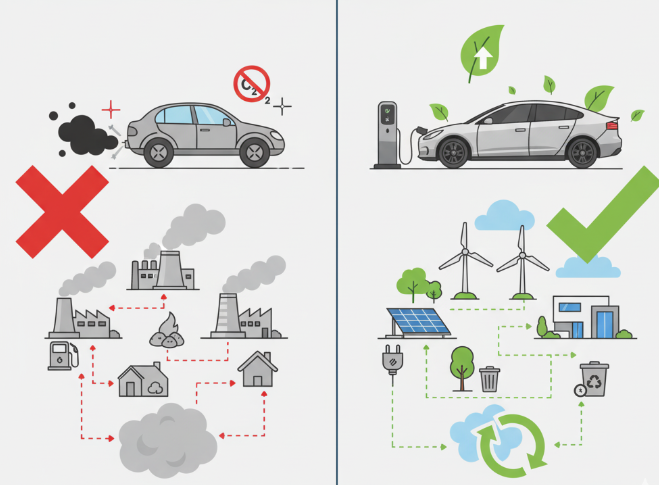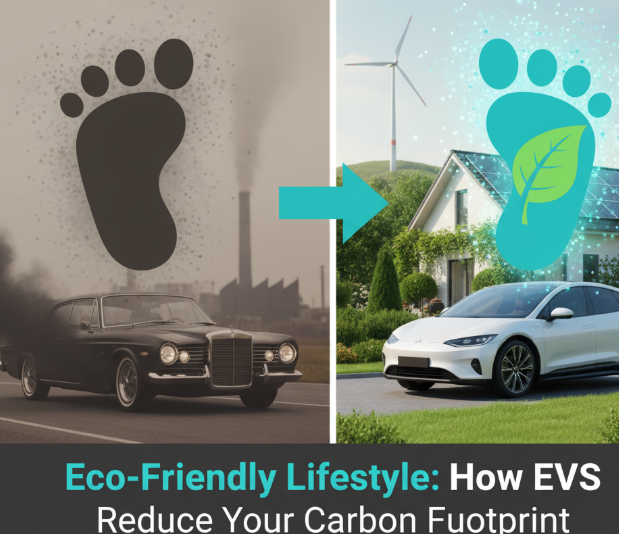Introduction
Every day, our choices impact the planet. From the food we eat to the way we travel, everything leaves behind a carbon footprint—the amount of greenhouse gases we produce through daily activities. Among these, transportation is one of the biggest contributors to climate change. Cars running on gasoline or diesel emit massive amounts of carbon dioxide (CO₂) and other harmful gases.
This is where electric vehicles (EVs) come in. They are no longer just futuristic ideas; they are real, practical, and growing in popularity worldwide. Beyond being cool and quiet, EVs play a huge role in living a more eco-friendly lifestyle. By replacing fossil fuel cars with electric ones, individuals can significantly cut down their carbon emissions, save money, and contribute to a healthier planet.
In this article, we’ll dive into the many ways EVs reduce your carbon footprint, how they fit into a sustainable lifestyle, and what the future of green transportation looks like.
Why Transportation Matters in Climate Change
The Problem with Gasoline Cars
- Gas-powered cars burn fossil fuels to run.
- Every gallon of gasoline burned produces about 8,887 grams of CO₂.
- Cars also release other pollutants like nitrogen oxides and particulate matter, which cause smog and health issues.
Transportation alone contributes around 24% of global CO₂ emissions, making it one of the top culprits in global warming.
The Promise of EVs
Electric vehicles run on electricity instead of gasoline. While the electricity may sometimes come from fossil fuels, EVs are still far cleaner over their lifetime compared to traditional cars. And as the grid becomes greener with renewable energy, EVs will only get better for the planet.
How EVs Reduce Your Carbon Footprint
1. Zero Tailpipe Emissions
Traditional cars release exhaust gases every time the engine runs. In contrast, EVs produce no tailpipe emissions. That means:
- No CO₂ directly from the car.
- No smog-causing pollutants in cities.
- Cleaner air for everyone.
This is especially important in crowded cities where air pollution is a major health problem.
2. Cleaner Energy Use
Even when powered by electricity from fossil fuels, EVs are more efficient. For example:
- A gasoline engine converts only 20–30% of the fuel’s energy into movement.
- An EV converts 60–77% of electrical energy into movement.
This efficiency means less energy wasted and fewer emissions overall.
3. Renewable Energy Integration
EV owners can charge their cars using renewable energy sources like solar or wind power. Imagine charging your EV at home with rooftop solar panels—your car would then run on 100% clean energy.
Many countries are rapidly adding renewables to their grids, which means that every year, EVs get cleaner.
4. Reduced Oil Dependence
Gasoline cars rely on oil extraction, refining, and transportation. Each step generates emissions and risks environmental disasters (like oil spills). By choosing EVs, we reduce global dependence on oil and encourage cleaner alternatives.
5. Lower Lifetime Emissions
Some argue that making EV batteries produces high emissions. While that’s partly true, multiple studies show that over the full lifetime, EVs still produce much fewer emissions compared to gas cars.
Here’s a simplified comparison:
| Vehicle Type | Manufacturing Emissions | Driving Emissions | Total Lifetime Emissions |
|---|---|---|---|
| Gasoline Car | Low | Very High | Extremely High |
| Hybrid Car | Medium | Medium | Lower but still High |
| Electric Vehicle (EV) | Higher (battery) | Very Low | Much Lower Overall |
6. Supporting a Circular Economy
Battery recycling is becoming more advanced. Companies are now reusing lithium, cobalt, and nickel from old EV batteries to make new ones. This reduces mining, saves resources, and cuts emissions.
Living Eco-Friendly with EVs
Switching to an EV is more than just buying a car—it’s adopting a lifestyle that supports sustainability. Let’s explore how:
Driving Habits that Boost Eco-Friendliness
- Charge smartly: Use renewable energy or off-peak charging times.
- Plan routes: Avoid traffic to reduce energy use.
- Eco-mode: Many EVs have driving modes that save energy.
- Carpool or share rides: Fewer cars on the road = fewer emissions.
Charging at Home vs Public Stations
- Home Charging:
- Convenient and cost-effective.
- Works best with renewable sources (like solar).
- Public Charging:
- Growing fast worldwide.
- Some stations even run on 100% renewable energy.
EVs and Smart Cities
EVs fit perfectly into future smart cities:
- Electric buses and taxis reduce urban pollution.
- Charging stations integrated into streetlights make EV use seamless.
- Smart grids balance energy use between homes, businesses, and EVs.
Myths About EVs and the Environment
Despite their benefits, EVs are surrounded by myths. Let’s clear a few:
- Myth: EVs are worse because of battery production.
- Truth: Manufacturing emissions are higher, but driving an EV quickly makes up for it. After about 1–2 years, EVs become cleaner than gas cars.
- Myth: Electricity comes from coal, so EVs aren’t clean.
- Truth: Even on coal-heavy grids, EVs still emit less. And grids are getting greener every year.
- Myth: EV batteries are not recyclable.
- Truth: Recycling is improving rapidly, and second-life uses (like energy storage) are becoming common.
The Bigger Picture: EVs and Climate Goals
Meeting Net-Zero Targets
Many countries aim to reach net-zero emissions by 2050. Transportation must go electric to achieve this. EVs are not the only solution, but they are a cornerstone of climate strategy.

Creating Cleaner Communities
- Noise pollution reduction: EVs are much quieter than traditional cars.
- Air quality improvement: Fewer asthma and lung disease cases in cities.
- Green jobs: Manufacturing EVs, charging infrastructure, and renewable energy creates millions of jobs.
Financial Benefits of EVs and Eco-Living
Going green isn’t just good for the planet—it’s good for your wallet too.
Cost Savings of EVs
- Fuel savings: Electricity is much cheaper than gasoline.
- Lower maintenance: Fewer moving parts = fewer repairs.
- Government incentives: Tax credits, rebates, and free charging in many places.
Eco-Friendly Lifestyle Benefits Beyond Cars
Owning an EV often inspires other sustainable choices, such as:
- Using solar panels at home.
- Switching to energy-efficient appliances.
- Recycling and reducing waste.
- Choosing public transport or cycling when possible.
Case Study: How EVs Cut Carbon Emissions
Let’s take an example:
- A driver uses a gasoline car for 12,000 miles per year.
- Average emissions: 4.6 metric tons of CO₂ annually.
Now, switch to an EV:
- Emissions: Around 1.5 metric tons annually (depending on grid mix).
- Net savings: 3.1 metric tons CO₂ per year.
That’s equal to:
- Planting 51 trees every year.
- Avoiding the burning of 350 gallons of gasoline.
Graph: Gas Cars vs EVs Emissions Over Time
Here’s a simplified graph idea:
Gasoline Car Emissions ──────────── Constant High
EV Emissions ──── Drops as grid gets cleaner
The longer you drive an EV, the more emissions you save.
Challenges and the Road Ahead
EVs are not perfect, and challenges remain:
- Battery recycling: Needs more infrastructure.
- Charging access: Must grow in rural and developing areas.
- Upfront costs: EVs are still pricier, though prices are falling fast.
Despite these, the momentum is unstoppable. By 2035, many countries plan to ban new gasoline car sales. EVs will become the norm, not the exception.
Conclusion: A Cleaner Future on Wheels
Adopting an eco-friendly lifestyle doesn’t mean changing everything overnight. Small steps add up, and one of the biggest steps you can take is switching to an electric vehicle.
EVs reduce your carbon footprint by:
- Eliminating tailpipe emissions
- Using cleaner energy sources
- Cutting oil dependence
- Supporting a circular economy through recycling
When combined with other sustainable habits—like renewable energy use, recycling, and efficient living—EVs become powerful tools in building a greener future.
The road ahead is clear: if we want a healthier planet for ourselves and future generations, embracing EVs and eco-friendly living is not just a choice—it’s a responsibility.

Leave a Reply